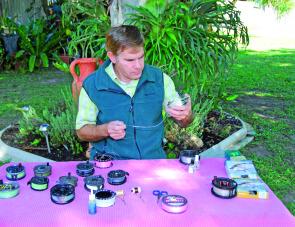June isn’t really a big month for fly angling. However, bream can still be caught on bread flies and small pink Crazy Charlies, and the bass are only a matter of weeks, or maybe even days, away from schooling up in the southern Queensland impoundments.
Even though there are still options around the catch rates are down, so I see the onset of winter as a prime time to have a very close look at tackle and make some necessary repairs and modifications. This little case study might explain why.
I was thinking of using a 10# weight forward floating line for my annual winter snapper on fly quest. In preparing the gear I peeled a bit of fly line off the big Snowbee reel, which had seen some serious barra fishing through summer.
The fly line didn't look dirty but a clean damp cloth run along the last few metres of the line certainly revealed it was far from clean – pretty filthy in fact. A few rubs along the line with the cleaning pad supplied with the Scientific Anglers Fly Line dressing kit removed a lot of the gunk and then a clean soft rag with some of the special Scientific Angler cleaning fluid was passed up and down the line from back to front a few times to further clean, smooth, and at the same time remove any twists from the line. I then allowed it to dry in the shade for a short while before winding it back on the reel. And what a difference I noted with a couple of casts, it was clean and felt very slick.
The above procedure is fine for a line that might be kept in use from time to time through winter, but what is the best procedure for fly lines that are not going to see use for some time?
A thorough clean and dry is the move and then, after removing any fine sections of leader tippet, I simply put the fly lines onto a wide spool I obtained from a local electrical retailer. The spool, being much larger than the fly reel, will allow the fly line to be stored in a situation where it's not being cramped or confined and thus retain an annoying memory, which can happen if it's left on the reel unused for months at a time.
Taking a look at some of the other heavy-duty 10# or 11# lines, I noted that some of the braided loops connecting the fly line and leader or backing to fly line were in need of repair. Attention to these is very important as a failure with a good fish on is nothing short of tragic given that big fish just don't come around often enough. Well, not for me anyway!
But, when fishing is really full on it's easy to overlook or take for granted these important connections and I'd be as guilty as the next person in this regard. “She'll be right” – it's the old time proven catch cry, usually followed by “what went wrong?”
If a binding is looking a bit frayed then it's time to either remove it or go over it again with more tying thread, complete with a neat whip finish at the end of the dressing and then apply a couple of coats of nail varnish for good measure.
Then it's time for the test; if a repair is necessary once the varnish has dried the idea is to take hold of the leader butt or backing (past the loop) in one hand, grab the fly line in the other and maintain a steady strain for a few seconds to see how strong the join is. If it survives this test then you can have confidence in the set up. I'd do the same with a connection that might not have needed repair but was a bit on the old side just to ensure that things stay put. Far better it breaks at home than on the water.
A close look at all knots and joins in leaders is also a good idea. It pays to understand that the tippet section of any leader is likely to be greatly weakened through exposure to UV rays and water. Both tend to rot the material, even fluorocarbon. My advice is to cut the tippet off and tie on another one when it's time to use the gear again.
Reels are not exempt from service either, particularly if they have had saltwater use. I always meticulously wash my reels down after use in the boat but do find that time spent pulling them apart to re-grease spindles, clean drags and remove what could be called 'gunk' from internal workings is time very well spent. Just don't go overboard with this business and slap cleaning fluid into drag washers and such.
A wipe with tissues dampened with a little Metho or Isocol will take care of frames and spindles just fine, while the drag washers should be cleaned gently only with tissue, little or no solvents unless the manufacturer recommends it.
A tiny application of reel grease will see the reel good as new and ready for storage or even more work. Look after the gear and it will look after you.
Reads: 1734
Take the time to run an eye over your tackle, as it will save heartache in the long run.

With these few items a lot of gear can be cleaned, tidied up, and running repairs to Gudebrod braid loops made.




